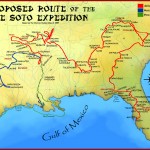 Spanish conquistador Hernando De Soto was the first European to explore deep inland within what would become the United States. For three years (1539-1542), his search for (non-existent) gold and a (non-existent) passage to China drove him and his men to cut a violent, disease-ridden swath through Florida, Georgia, the Carolinas, Tennessee, Alabama, Mississippi, Arkansas, Oklahoma, Louisiana and Texas.
Spanish conquistador Hernando De Soto was the first European to explore deep inland within what would become the United States. For three years (1539-1542), his search for (non-existent) gold and a (non-existent) passage to China drove him and his men to cut a violent, disease-ridden swath through Florida, Georgia, the Carolinas, Tennessee, Alabama, Mississippi, Arkansas, Oklahoma, Louisiana and Texas.
Very little in the way of archaeology has been found marking his route. What we know of it has mainly been pieced together with difficulty from his journals and from tribal oral histories, all of which use references to features of a landscape long gone. The only confirmed site is in Tallahassee, Florida, where they wintered the first year. Any discovery of material remains left behind by the expedition, therefore, is of major historical significance.
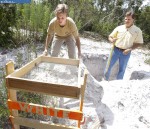 Archaeologist Ashley White has found strong evidence on his own family property that De Soto’s team stopped there in the summer of 1539 when it was an Indian town called Potano near present-day Orange Lake in north Marion County, Florida. White had explored the 700-acre property before looking for the remains of a 17th century Spanish cattle ranch he thought might have been there, but all he found were relatively common Indian artifacts.
Archaeologist Ashley White has found strong evidence on his own family property that De Soto’s team stopped there in the summer of 1539 when it was an Indian town called Potano near present-day Orange Lake in north Marion County, Florida. White had explored the 700-acre property before looking for the remains of a 17th century Spanish cattle ranch he thought might have been there, but all he found were relatively common Indian artifacts.
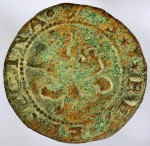 It was Florida weather that ultimately showed him the way. Heavy rainfall in 2005 flooded the land. When it drained away, it took hardened sand with it, leaving once-buried artifacts totally exposed on the surface. On the west bank of an old creek, Dr. White found a copper coin from the late 1400s. East of the creek bed, White, his bioarchaeologist wife Michele and their son Ethan found even more coins — ultimately they recovered 100 cooper coins minted in Spain between 1556 and 1621 — plus Murano glass trade beads, Spanish blue on white porcelain and postholes.
It was Florida weather that ultimately showed him the way. Heavy rainfall in 2005 flooded the land. When it drained away, it took hardened sand with it, leaving once-buried artifacts totally exposed on the surface. On the west bank of an old creek, Dr. White found a copper coin from the late 1400s. East of the creek bed, White, his bioarchaeologist wife Michele and their son Ethan found even more coins — ultimately they recovered 100 cooper coins minted in Spain between 1556 and 1621 — plus Murano glass trade beads, Spanish blue on white porcelain and postholes.
 During the first two years of excavations, White’s working hypothesis was that they had discovered the remains of that early Spanish cattle ranch. When he examined the artifacts and the architecture of the building remains in detail, however, he realized they were very similar in style to what you see in Spanish missions built along Indian trails in Florida. The missionaries used De Soto’s journals and maps to determine where the potential converts were located.
During the first two years of excavations, White’s working hypothesis was that they had discovered the remains of that early Spanish cattle ranch. When he examined the artifacts and the architecture of the building remains in detail, however, he realized they were very similar in style to what you see in Spanish missions built along Indian trails in Florida. The missionaries used De Soto’s journals and maps to determine where the potential converts were located.
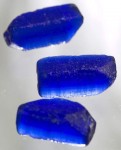 Returning to the other side of the creek where he had found the 15th century Spanish coin, White found another two from around the same period. The three copper coins were two Ferdinand and Isabellas (1497-1504) and one Enrique IV (1471-74), at least half a century older than the ones at the mission site. He also found seven beautiful cobalt blue Nueva Cadiz beads from around 1520, probably originally arranged into a crucifix, and more Venetian glass trade beads, these ones older and more elaborate than the ones on the east side of the creek.
Returning to the other side of the creek where he had found the 15th century Spanish coin, White found another two from around the same period. The three copper coins were two Ferdinand and Isabellas (1497-1504) and one Enrique IV (1471-74), at least half a century older than the ones at the mission site. He also found seven beautiful cobalt blue Nueva Cadiz beads from around 1520, probably originally arranged into a crucifix, and more Venetian glass trade beads, these ones older and more elaborate than the ones on the east side of the creek.  The facets, multi-layered coloring and chevron patterns of the Murano beads are identical to other beads found at the known De Soto site in Tallahassee and the suspected De Soto site found three years ago in Georgia.
The facets, multi-layered coloring and chevron patterns of the Murano beads are identical to other beads found at the known De Soto site in Tallahassee and the suspected De Soto site found three years ago in Georgia.
Then White found a few links of iron chain mail from Spain, with designs De Soto’s men would have woven onto their garments to protect them from Indian spears and arrows. The way the chain mail was linked predated the mission.
He also unearthed a pig jaw, unique to the domesticated herd of European animals De Soto brought to help feed his men.
There had been other Spanish explorers, such as Panfilo de Narvaez, but they had not brought Old World pigs, nor had they traveled as far inland.
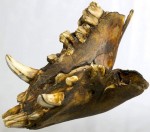 Experts have analyzed the finds and so far all the results confirm they were left by the De Soto expedition. A numismatics curator at Princeton confirmed that the three coins were of the age and type used to pay De Soto’s troops and workers. The chevron beads were sent to Italy to confirm they were of 16th century Murano origin. Radiocarbon dating found the Sus scrofa, a long-legged black Spanish domestic pig, to whom the jawbone was once attached was slaughtered in 1539. Several museums compared the chain mail to Spanish pieces in their collections and found it was manufactured in Spain between 1490 and the 1530s. X-ray fluorescence testing confirmed that the iron in the mail dates to the 15th century.
Experts have analyzed the finds and so far all the results confirm they were left by the De Soto expedition. A numismatics curator at Princeton confirmed that the three coins were of the age and type used to pay De Soto’s troops and workers. The chevron beads were sent to Italy to confirm they were of 16th century Murano origin. Radiocarbon dating found the Sus scrofa, a long-legged black Spanish domestic pig, to whom the jawbone was once attached was slaughtered in 1539. Several museums compared the chain mail to Spanish pieces in their collections and found it was manufactured in Spain between 1490 and the 1530s. X-ray fluorescence testing confirmed that the iron in the mail dates to the 15th century.
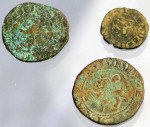 According to Jerald Milanich, an expert in De Soto’s expedition who has written multiple books on the subject and who is the archaeology curator emeritus at the University of Florida’s Florida Museum of Natural History, “there is absolutely no doubt that is a De Soto contact site,” and he is “99.99 percent sure this is the town of Potano, the major Indian town.” De Soto sought out Native American settlements in his eternal search for food and in the hope that they could tell him where all the (non-existent) gold was. He would have traded the glass pieces in exchange for food, but also occupied the town with his army to plunder their food stores and infect them with measles and smallpox while he was at it.
According to Jerald Milanich, an expert in De Soto’s expedition who has written multiple books on the subject and who is the archaeology curator emeritus at the University of Florida’s Florida Museum of Natural History, “there is absolutely no doubt that is a De Soto contact site,” and he is “99.99 percent sure this is the town of Potano, the major Indian town.” De Soto sought out Native American settlements in his eternal search for food and in the hope that they could tell him where all the (non-existent) gold was. He would have traded the glass pieces in exchange for food, but also occupied the town with his army to plunder their food stores and infect them with measles and smallpox while he was at it.
Eventually he moved on, going north to Tallahassee, doubtless to the great relief of the Potano Indians. In 1542, Hernando De Soto died of a fever on the banks of the Mississippi and was buried in secret, possibly in the Mighty Mississip’ itself, by his comrades who wanted to keep the locals thinking that he was the incarnation of the sun god instead of a puny human. Sixty-four years later, the Spanish returned to the Potano where they built the Mission San Buenaventura de Potano by the creek just east of De Soto’s old encampment.
The Ocala Star-Banner has the most in depth coverage of this discovery, including an excellent photo gallery. Keep an eye on their Discovery De Soto page for more news as it develops.